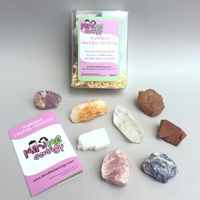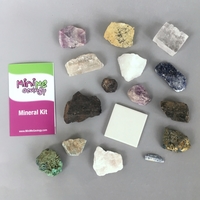Igneous Rock Identification Flow Chart
PRINT AN IGNEOUS ROCK IDENTIFICATION FLOW CHART
You can download and use our Igneous Rock Identification Flow Chart for another fun way of identifying the rocks in many of your Mini Me Geology kits. The link to download and print your free igneous rock identification flow chart is located at the top of this page.
We have designed this flow chart to help you identify your rocks. To use our Igneous Rock Identification Flow Chart, it will be easiest if you print out your own copy first. The flow chart moves from left to right, following the arrows.
- No Crystals where the rock does not have any crystals. These rocks are either:
Glassy where the rock looks like a piece of colored glass
Vesicular where the rock has no crystals but has many, many tiny holes
(these rocks are often very light weight)
- Fine-Grained where you can not see each individual crystal (very tiny crystals)
- Medium-Grained where you can see the individual grains (medium size crystals)
- Coarse-Grained where you can very easily see the individual grains (large size crystals)
Keep in mind that your rock may have more than one grain size. It is very common to find some rocks with large crystal grains in a rock with fine crystal grains. These types of rock will look like the large crystal grains are “floating” inside the rest of the rock.
Step 3: Determine the Color – The next step is to decide the color of your igneous rock. Some igneous rocks can be a more than one color so choose the color that most closely matches the overall color of your sample. With color, you are looking for the color of most (more than half) of the crystal grains.
Step 4: Test Special Features – Many of the special features can been seen by looking through your hand magnifier. One of the rocks will float in water so ask your parents for a small bowl with some water for your test. Sometimes, the special features are needed to identify your igneous rock, other times, the special features are simply fun to see.
Follow these steps for each of your igneous rock samples until you identify them all. If you need help, grab an adult and give us a call!



